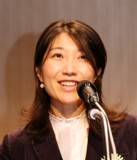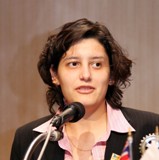��Rotary Foundation Month�� Meeting
��Rotary Foundation Scholar Days and Thereafter��
November 7, 2007
Ms. Kyoko Hidaka,
Former Rotary Foundation Ambassadorial Scholar (1996-98),
Part-Time Lecturer, Tama Art University
Ms. Ana Galvez,
Rotary Foundation World Peace Fellow,
Graduate School, International Christian University
 ��Rotary Foundation Scholar Days and Thereafter��
��Rotary Foundation Scholar Days and Thereafter��
Ms. Kyoko Hidaka
1. Self Introduction
I graduated from the Faculty of Fine Arts at the Tokyo University of the Arts and I am currently a part-time lecturer at Tama Art University and at Daito Bunka University. For 2 years between 1996 and 1998, I studied in London as a Multi Year Ambassadorial Scholar. The sponsoring club was the District 2580 Tokyo Ueno Rotary Club and the host club was the district 1130 Leyton Rotary Club. London was a very cosmopolitan city. All of the members of the Leyton Rotary Club were Indian and the doctor who was the counselor was also an Indian. In London, it is said that there is a Rotary Club exclusively for Middle Eastern people.
2. What did I learn?
I studied at the Royal College of Art. My majors were chromatics and history of ornamental art. My study theme during the master��s and doctoral courses was ��Color of England from the late 16th Century to the late 17th Century��.
England became an imperial power from the late 16th century, and with the development of an absolute monarchy and class society, ��color�� became the code representing the class, position and religion, or something similar to a badge. I focused on ��gold, silver, and black�� in my research.
3. Particular items I learned from the English society
My first impression was that English people treasure old items, although this is widely recognized. They record and exhibit these items as pieces of history. This is a posture of making efforts to have communication with the people by using an item.
The second impression was that I felt that it was clearly a class society. My study mates often remarked on their social status such as, ��I am from the middle class�� or ��I am from the upper middle class��. They are aware of what class ranking into which they were born. On the other hand, they remark, ��I am studying to earn my master��s degree and I wish to work in that field��. In other words, they are attempting to escape from the class society.
Thirdly, London is a city that accepts a multiracial society. It is usual that the store clerks are not English. In such a society, communication among the people is extremely important. It is not a society where the idea that even something unsaid would be understood would be true. I felt that it is a society where there is an attitude toward giving clear explanations by written or verbal means and passing on their own will, and understanding the other party��s will and achieving mutual understanding.
4. Japanese Traditional Chromatic Culture
��It was Prince Shotoku who introduced the Twelve Level Cap and Rank System into Japan. The ranks were divided into 6 Confucian virtues: virtue, benevolence, propriety, sincerity, justice, and knowledge�� which was further subdivided to make twelve levels. The colors were purple, blue, red, yellow, white, and black��. The subdivisions were differentiated using the shades of the colors.
��In the traditional culture of colors during the Heian Period, there is ��the arrangements of the layers and their colors (KASANE NO IROME)��. It is said to be some 200 types of combinations.
��In the Edo Period, there was a townspeople culture called the ��48 Shades of Brown and 100 Grey�� using brown and grey as the base.
5. My current research
��In England, from the 18th century, a need to accurately pass on the thoughts of the designers to the producers in the colonies overcoming language barriers arose. To this end, many color samples and design samples were created over the 19th century. This is my current research theme.
6. About the future
I advise those students applying for a Rotary Scholarship of three things.
First if you are selected, be thankful. Have the spirit of appreciation to the sponsors and to those who were not awarded. Second, have pride and awareness that you are representing Japan. Thirdly, in your study location, do not lose sight of your objectives and put them into practice. This is my advice to these students.
��Myself also, making use of my experience as an international student and background as a returnee child, I have the ambition of becoming involved in international cultural exchange activities in the art and design fields.
 ��My Visit to the Rotary Club of Tokyo��
��My Visit to the Rotary Club of Tokyo��
Ms. Ana Galvez
��Last year, when I was in Israel, I was notified that I had qualified as a World Peace Fellow under the Rotary Foundation Educational Program.
��Whether the country is a developing country or an advanced country, it is important to foster a spirit of tolerance without violence through social justice.
��To enhance knowledge of this issue, I am studying the relationship between politics and peace at the Graduate School of the International Christian University in Japan.
��My research is on the following three themes
1. Thinking about resolutions to international conflicts
2. Thinking about public policy
3. Thinking about methods for international cooperation
��I wish to focus my research on Latin America and the Middle East, in particular Israel and Palestine.
��I would like to express appreciation, on behalf of the Argentinean club, to the Rotary clubs in Japan, the counselors, and their families, and the people in Japan who support the Rotary Foundation Educational Program. I wish for your continued support. Thank you very much.